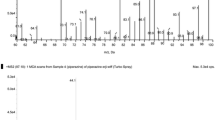Abstract
A high-performance liquid chromatographic method for the determination of levamisole (LVM) residues in sheep muscle tissue is described. LVM was extracted with ethyl acetate under alkaline conditions and cleanup was performed by liquid-liquid partition between organic-basic and organic-acid medium. Finally, levamisole was back extracted with chloroform carefully transferred into a clean glass vial and evaporated to dryness at 50 °C under a gentle stream of nitrogen. The remaining dry residue was dissolved in the mobile phase used, filtered and an aliquot was injected automatically into the chromatograph for analysis. Chromatography was performed on a Zorbax®SB-C18 column at 50 °C and detection by a PDA detector monitored at λ max 220 nm. The mobile phase was a mixture of 0.1 % trifluoroacetic acid (v/v) pH 2.0 and acetonitrile-methanol 3 : 2 (v/v) in a combination of 30 : 70 (v/v) and a flow rate of 1.0 mL min−1, delivered isocratically. This analytical method was validated by assessing recovery efficiency using spiked muscle tissue samples with standard solutions in methanol at four fortification levels of 1/2 MRL, 1 MRL, 2 MRL and 4 MRL and five times for each concentration (n = 5). Mean recovery (R%) achieved for muscle tissue was 75.65 ± 2.74% with an acceptable Relative Standard Deviation RSD% = 10.4. The same method was used also for the analysis of kidney, liver and fat (perirenal) and the recoveries found were 70.25 ± 1.07% (RSD% = 1.52), 72.37 ± 3.6% (RSD% = 4.97) and 69.44 ± 2.22% (RSD% = 3.19), respectively. The limit of detection (LOD) for muscle tissue was found to be 2.0 µg kg−1 and the limit of quantification (LOQ) 5.0 µg kg−1.
Similar content being viewed by others
References
Braund KG (2003) In: Clinical Neurology in Small Animals-Localization, Diagnosis and Treatment, Braund KG (Ed.), Ithaca. International Veterinary Information Service, USA, pp. 1–23
Cherlet M, de Baere S, Croubels S, de Backer P (2000) J Chromatogr B 742:283–293
Sahagun AM, Teran MT, Garcia JJ, Fernandez N, Sierra M, Diez MJ (2001) J Vet Pharmacol Ther 24:439–442
IPCS (1991) In: Toxicological evaluation of certain veterinary drug residues in food. The thirty-sixth meeting of the joint FAO/WHO expert committee on food additives (JECFA). WHO Food additives series: 27. International Programme on Chemical Safety. World Health Organization, Geneva, pp. 75–101
Dolezalova M. Tkaczykova M (2001) J Pharm Biomed Anal 25:407–415
Chankvetadzea B, Burjanadze N, Santi M, Massolini G, Blaschke G (2002) J Sep Sci 25:733–740
Woestenborghs R, Michielsen L, Heykants J (1981) J Chromatogr, 224:25–32
de Bukanski BW, Degroodt JM, Beernaert HZ (1991) Z Lebensm Unters Forsch A 193:545–547
Vandamme TF, Demoustier M, Rollmann B (1995) Eur J Drug Metab Pharmacokinet 20:145–149
Dreassi E, Corbini G, La Rosa C, Politi N, Corti P (2001) J Agric Food Chem 49:5702–5705
De Ruyck H, Daeseleire E, de Rider H, Van Renterghem R (2002) J Chromatogr A 976:181–194
Edder P, Ortelli D, Jan P, Corvi C (2004). In EURORESIDUE V Conference on Residues of Veterinary Drugs in Food. 1st ed. van Gingel LA, Bergwerff AA (ed.) Colophon, Noordwijkerhout, The Netherlands, pp. 466–469
De Ruyck H, Van Renterghem R, De Ridder H, De Brabander D (2000) Food Control 11:165–173
COMMISSION REGULATION (EC) No 508/1999 of 4 March 1999 amending Annexes I to IV to Council Regulation (EEC) No 2377/90 laying down a Community procedure for the establishment of maximum residue limits of veterinary medicinal products in foodstuffs of animal origin. OJEC L 60/16 9. 3. 1999.
Tyrpenou AE, Tsigouri AD, Gouta-Papastavrou E (1995) In: Proceedings of the Greek Congress “Food quality and consumers' demands beyond 2000”. DETROP '95 Thessaloniki, Greece, pp. 34–35
Tyrpenou AE, Rigos G (2004) Chromatographia 60:657–661
El-Kholy H, Kemppainen BW (2003) J Chromatogr B 796:371–377
Author information
Authors and Affiliations
Corresponding author
Additional information
Revised: 4 and 24 January 2006
Rights and permissions
About this article
Cite this article
Tyrpenou, A.E., Xylouri-Frangiadaki, E.M. Determination of Levamisole in Sheep Muscle Tissue by High-Performance Liquid Chromatography and Photo Diode Array Detection. Chroma 63, 321–326 (2006). https://doi.org/10.1365/s10337-006-0754-5
Received:
Accepted:
Published:
Issue Date:
DOI: https://doi.org/10.1365/s10337-006-0754-5




